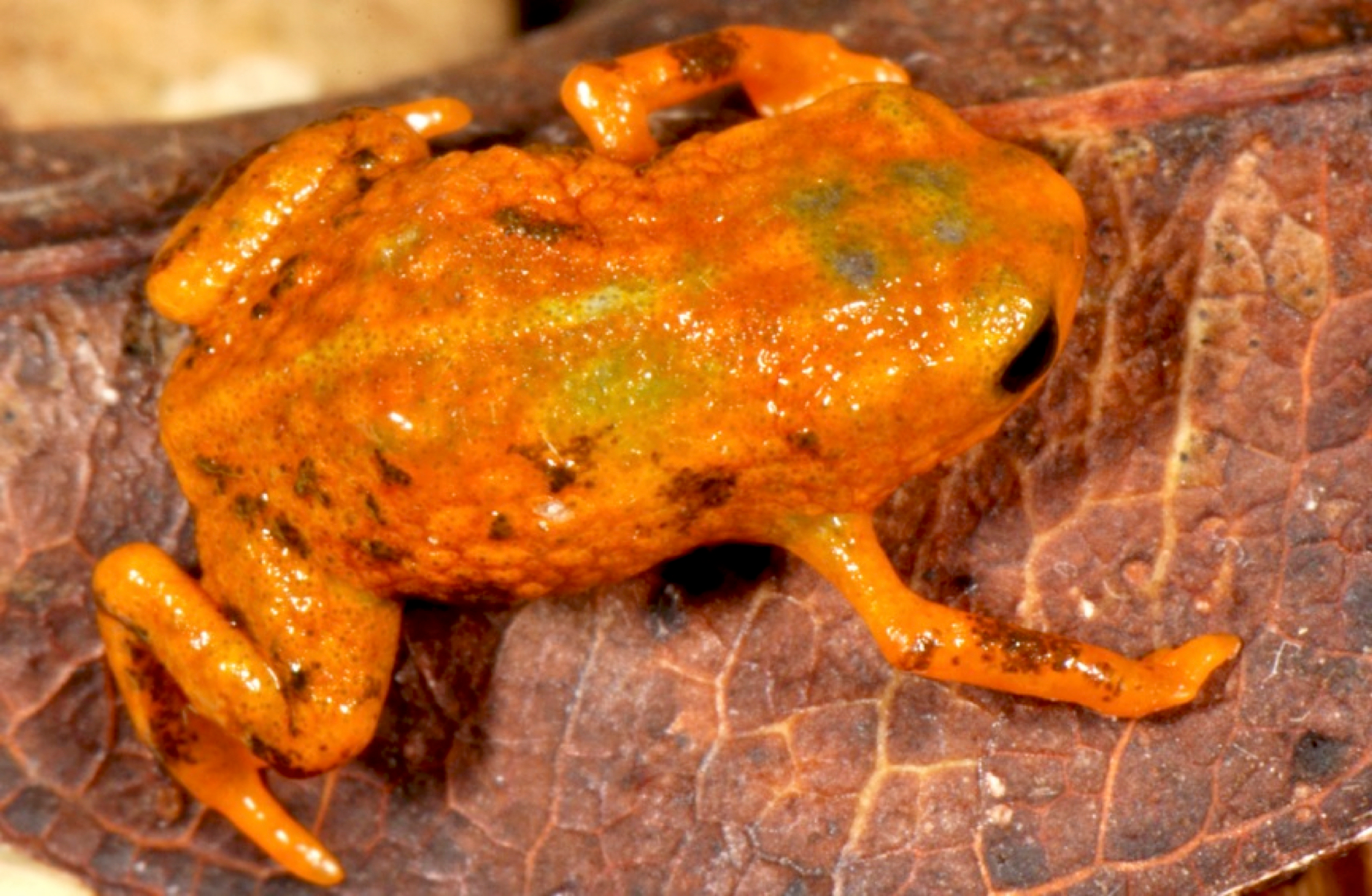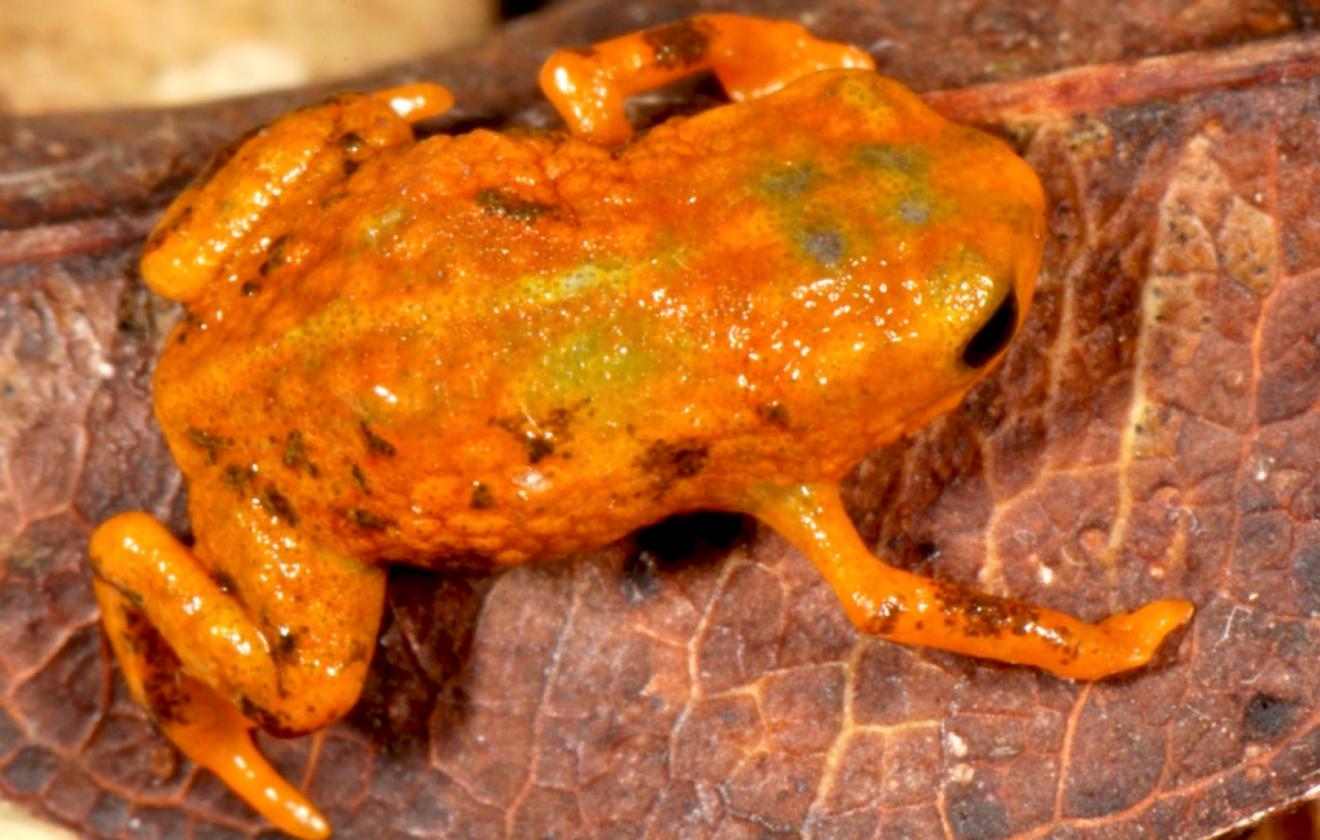- Brachycephalus mariaeterezae: Discovering Brazil's Golden Jewel of the Atlantic Forest
Brachycephalus mariaeterezae: Discovering Brazil’s Golden Jewel of the Atlantic Forest#
Hidden amongst dense foliage, nestled quietly amidst fallen leaves in Brazil’s lush Atlantic Forest, lives an enchanting creature—yet unknown to many. Measuring no more than a fingertip and adorned in startling shades of gold and orange, Brachycephalus mariaeterezae is as rare as it is captivating.
It seems incredible that within our modern world, teeming with billions of people, we still uncover new creatures. Yet, as recent as the twenty-first century, a miniature, vibrant amphibian emerged from science’s blind spots, instantly capturing the imagination of conservationists and biologists alike. Discovered officially only in 2015, this remarkable species continues to astonish those fortunate enough to encounter it. Named in honor of Maria Tereza Jorge Pádua, a dedicated Brazilian environmentalist and passionate advocate for conservation, this tiny amphibian underscores the wondrous biodiversity housed within Brazil’s precious Atlantic biome.
Taxonomy and Classification#
Brachycephalus mariaeterezae is a member of the specialized genus Brachycephalus, belonging to the family Brachycephalidae. Colloquially known as “pumpkin toadlets,” species within this genus are famed for their minute sizes, vivid coloration, and unique adaptations. Within taxonomic circles, Brachycephalus represents a fascinating lineage characterized by evolutionary specialization and considerable endemism.
The genus Brachycephalus dates back millions of years, evolving in isolation within Brazil’s mountainous Atlantic Forest. This evolutionary process created unique morphological changes and adaptations conducive to life within specific microhabitats. Among its closest relatives, Brachycephalus mariaeterezae shares close genetic ties with equally fascinating counterparts—such as Brachycephalus ephippium—yet each species maintains distinctive anatomy and behaviors, carving out very particular ecological niches.
Natural Habitat#
A Fragile Eden: Brazil’s Atlantic Forest#
Inhabiting exclusively small regions within the Atlantic Forest mountain ranges in southeastern Brazil, Brachycephalus mariaeterezae navigates an environment shaped profoundly by moisture, lush vegetation, and altitude. Thriving typically above 1,000 meters, this frog primarily prefers higher altitudes—cloud-shaded montane forests steeped in perpetual humidity. Dense patches of leaf litter, moss-carpeted rocks, and shaded crevices amid tangled roots create an ecological tapestry uniquely suited for this pint-sized amphibian.
Rain and mist drape these habitats constantly, forming a delicate balance of temperature and moisture—an ideal sanctuary for a species whose skin requires constant hydration and protection. Due to these highly specialized habitat requirements, Brachycephalus mariaeterezae exhibits extremely limited distribution, restricted often to hillsides and isolated mountaintops within a fragmented and threatened forest ecosystem.
Navigating a Microcosmic Landscape#
Within their specialized terrain, these frogs painstakingly traverse the leaf litter with cautious deliberation. Their movement is slow, careful, and deliberate, conferring upon these tiny frogs a dignified air of cautious curiosity. They are adept climbers within their scale’s constraints, carefully occupying mossy branches and leaf clusters. Every moss-covered rock and damp droplet becomes a waypoint, a transient refuge where quiet survival unfolds each day.
Physical Characteristics#
Small Wonders Wrapped in Scarlet and Gold#
Brachycephalus mariaeterezae rarely exceeds 1.5 centimeters in length from snout to vent. Their remarkably tiny bodies are robust, rounded, and devoid of the characteristic long legs seen in many frogs. Indeed, their compact shape more closely resembles miniature jewels. Almost luminous in appearance, their striking coloration serves as both their hallmark and survival strategy.
The bright hues—bold golden oranges mingled with vivid yellows and reds—reflect toxins present beneath the skin. This aposematic coloration immediately signals danger, warning predators of the toxins contained within. These toxins, primarily tetrodotoxins, derive from dietary sources and accumulate within glands hidden beneath their bright skin, providing an effective barrier against predation.
Adaptations for Survival: A Life of Toxins and Colors#
Indeed, the colorful exterior is no mere aesthetic marvel—it is a rich historical artifact of evolution. Those vibrant tones, rather ironically, conceal a fragility. Brachycephalus mariaeterezae possesses some of the thinnest, most delicate skin among amphibians. This delicate skin is sensitive and permeable; moist habitats aren’t merely preferred—they’re vital. Without constant humidity and protective microhabitats, the frogs quickly succumb to dehydration or environmental stress.
Behavior and Life Cycle#
Feasting in Miniature: Diet and Hunting Habits#
As diminutive predators, these tiny frogs primarily consume an equally minuscule diet, favoring small arthropods such as mites, ants, springtails, and miniature beetles. Hunting defined by precision rather than brute force, Brachycephalus mariaeterezae relies on stealth and patience, patiently stalking prey through leaf litter’s intricate labyrinth. Upon spotting suitable prey, they employ swift tongue movements to capture their meal—a display of extraordinary precision at microscopic scales.
Romantic Serenades and Quiet Courtship#
Mating rituals typically occur during rainy seasons, often occurring discreetly amidst dense vegetation. Unlike many frogs whose boisterous calls resonate audibly through nights, Brachycephalus mariaeterezae produces surprisingly subtle vocalizations—faint, insect-like croaks barely audible to human observers. This quiet chorus underscores an intricate courtship, with males calling cautiously amidst leaf litter, ultimately attracting females for brief yet secretive rendezvous.
Egg-laying occurs inconspicuously among wet leaf litter and moist forest detritus. Unlike typical frogs, Brachycephalus mariaeterezae bypass the free-swimming tadpole stage entirely. Embryos complete their development within the protective egg, emerging as fully formed miniature froglets, ready immediately to navigate the complex forest microhabitat.
Ecological Role#
Despite their diminutive size, Brachycephalus mariaeterezae assumes critical roles within their ecosystems. They serve as important consumers within micro-food webs, controlling arthropod populations and balancing arthropod-driven nutrient cycles. Simultaneously, due to their small size and vulnerability, they also feature as prey to select endemic predators with specialized tolerances to their toxins.
Perhaps most significantly, these sensitive amphibians function as indicator species, whose presence—or absence—reflects broader environmental health. Given their dependence on pristine conditions and specific microhabitats, their very existence underscores the health and stability of their Atlantic Forest ecosystem and signals impending ecological threats.
Threats and Conservation Status#
Disturbingly, despite the recent nature of its discovery, Brachycephalus mariaeterezae is already classified as at significant risk, primarily due to habitat fragmentation and deforestation within the Atlantic Forest. The International Union for Conservation of Nature (IUCN) has yet to formally assess this species, amplifying the urgency of conservation measures.
Climate change further imperils populations by disrupting rainfall patterns, altering microhabitats, and challenging the frogs’ narrow habitat preferences. Conservation programs and ecological research currently target habitat protection, reforestation efforts, and raising local awareness to safeguard this fragile amphibian jewel.
Cultural and Scientific Significance#
The species name “mariaeterezae” pays homage to Maria Tereza Jorge Pádua, a seminal figure whose tireless conservation efforts have dramatically reshaped Brazil’s environmental landscape. This frog symbolizes Brazil’s biodiversity richness, representing both the marvels of ecological discovery and responsibility toward conservation.
Conclusion: Protecting Brazil’s Hidden Treasures#
Brachycephalus mariaeterezae embodies the enchanting allure of the natural world—an exquisite marvel, small yet impactful. Our awareness and action can safeguard these creatures and their habitats, underscoring humanity’s role as stewards of biodiversity.
This miniature amphibian, unknown to most, calls us toward greater appreciation, preservation, and responsibility. By exploring deeper and supporting conservation actively, we can ensure Brachycephalus mariaeterezae remains a symbol of hope and resilience nestled quietly within the dappled sunlight and luxuriant foliage of its Atlantic Forest home—forever vibrant, forever protected.








